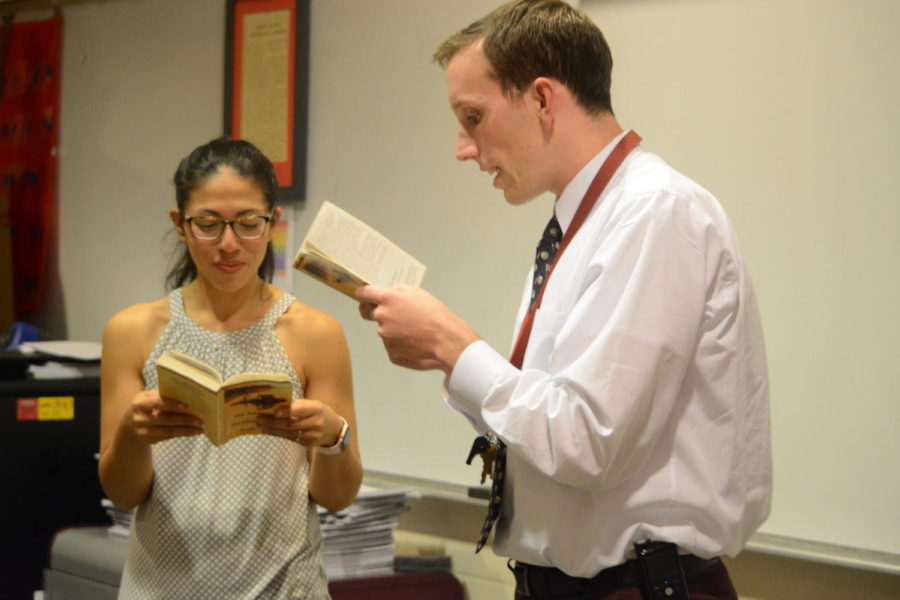American Studies engages students in interdisciplinary work
It takes two– English teacher MJ Martinez (left) and social studies teacher Patrick Mulcahy (right) read The Adventures of Huckleberry Finn by Mark Twain together as part of third unit of the new American Studies Honors course. The course runs twice a day for two periods and fulfills both the English and United States History requirements for juniors.
November 3, 2018
A new course is being offered to those who are looking to switch up their learning style and take an honors-level course. American Studies Honors is a double-period interdisciplinary class that combines the English and social studies requirements for junior year and is co-taught by an English teacher MJ Martinez and social studies teacher Patrick Mulcahy
“The American Studies course is unique in that it takes an interdisciplinary approach to American history. Throughout the year, students will be engaging in a study of modern U.S. history through the examination of American literature, music, culture, and more. Having both an English and history teacher in the room provides students with different insights into the story of America,” Mulcahy said.
Students who do not take Advanced Placement United States History (APUSH) are automatically enrolled in American Studies Honors; however, both courses are framed under a similar course essential question: “How have the ideals of the Declaration of Independence been upheld?” Throughout the course, students will dive deeper into topics such as American identity, democratic ideals, the tensions between the individual and American society, diverse perspectives on the American Dream, and active citizenship.
According to the teachers, literature will lead the historical teachings of the course. Since it is a new course, both Martinez and Mulcahy have been open to exploring students’ interests and introducing students to diverse perspectives.
“[My teacher] had our class brainstorm a list of things we want to learn about in American history. We just started learning about the causes of the Civil War and one topic is the treatment of Native Americans. It’s already very interesting to see how history is seen so differently based on the perspective of the people creating the literature,” junior Kiara Azarigian said.
While about two-thirds of junior students take APUSH, some students in American Studies were drawn to the combination of the two humanities courses.
“I chose to take American Studies because I feel like the combined class would provide me with a better opportunity to apply my learning….It’s a really interesting twist on any traditional history course,” junior Evan Pescosolido said.
Aside from the double-blocked period, the population size is unorthodox for a typical high school class. According to the teachers, each section has between 44-47 students each period, which is large in comparison to the average 18 students in an English classroom and 17 in a mathematics class.
“At first, the size seemed a little overwhelming, and I worried about building personal relationships with my students since that has always been a priority for me. However, I’ve learned that there are a lot of opportunities for creative community building with a class sizes this large. I also think it is a good experience for students to learn how to function productively with that many students at once. I absolutely love working with all of them,” Martinez said.
In order to support all of the students, the teachers have support staff and experiment with flexible groupings. According to the teachers, the course serves as not only a good opportunity for the students to learn in different formats, but also for them to experiment with new ways to teach.
“This course has changed the way I view teaching entirely. With such a large group of students, Mrs. Martinez and I have been forced to think outside the box about what types of activities will engage students. At the end of the year, we hope that most students will say that they enjoyed the combined course more than having two separate English and history classes. In order to achieve this goal, we will need to consistently develop innovative lessons that are appropriate for all of the learners in our classroom,” Mulcahy said.
In addition to traditional classroom learning, the teachers hope to build in opportunities to leave campus for learning opportunities. On October 23, the students visited the Mark Twain House as part of their unit, “Mark Twain, Satire, and Social Commentary.” Through this unit of study, the students are not only learning about Twain’s life during the Gilded Age, but also examining how The Adventures of Huckleberry Finn serves as satire and social commentary.
“I visited the Mark Twain House last year and knew right away that the students would really benefit from a tour. The staff is extremely knowledgeable and creates rich experiences for visitors and can readily make connections to school curricula upon request,” Martinez said.
The field trip took place periods two through eight. During their visit, the students toured Twain’s home, the museum, and participated in a learning lecture focused on Twain’s life in the Gilded Age.
“Going to the Mark Twain house was beneficial because I learned a lot about his work, personal life, and personality which helped me better understand the tone he uses in his books and the purpose of them. I also learned what inspired him to write his books which was super beneficial and interesting,” junior Olivia Kuczynski said.
Mulcahy and Martinez hope to do more outside learning experiences in the future and looks forward to experimenting with the curriculum.


